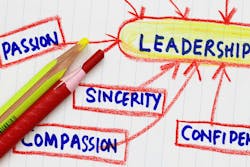Whether your natural leadership style is akin to a coach (leading with your heart), a visionary (leading with your head) or an executor (leading with your hands), your approach likely has various benefits and pitfalls. One expert outlines these three leadership styles and offers tips for embracing your strengths and addressing your blind spots.
Barbara Trautlein, Ph.D., author of Change Intelligence: Use the Power of CQ to Lead Change that Sticks, has more than 25 years experience helping businesses lead change. She says contemporary leaders must have a high CQ, or “change intelligence.”
“Today’s marketplace is in a state of constant change, and successful companies are those that can also respond and quickly adapt to the changes around them,” said Trautlein. “That requires leaders who are able to lead with the head – focusing on the big-picture goal and business objectives; the heart – knowing how to engage, coach and motivate people; and with your hands – providing the tactical tools and skills necessary like a project manager.
“People tend to be stronger in one or two of those areas and weaker in the others,” she added. “We need to identify our weak areas and work on strengthening them.”
That means leaders should ask themselves if they lead with their heads, hearts or hands.
Heart, Head and Hands
The Coach (Heart-dominant):
Strengths
- Encourages people to join in discussions, decisions.
- Steps in to resolve process problems, such as conflict.
- Listens to all viewpoints.
- Recognizes and praises others for their efforts.
- Helps reduce stress by lightening the mood.
Weaknesses
- Sees team process and organizational climate as ends in themselves.
- Fails to challenge or contradict others.
- Does not recognize the importance of accomplishing tasks.
- Overuses humor and other conflict-mitigation techniques.
- Does not emphasize long-range planning.
Advice for coaches: Make connections with people but also connect them with the mission. Don’t allow engagement to take precedence over performance.
The Visionary (Head-Dominant)
Strengths
- Stays focused on goals.
- Engages in long-range thinking and planning.
- Takes a big-picture view.
- Enjoys seeing new possibilities.
- Scans the horizon for the next big opportunity.
Weaknesses
- Doesn’t fully consider the effects a change will have on organizational culture.
- May be less apt to focus on team members’ individual needs.
- Complains about lack of progress toward goals.
- Does not give sufficient attention to the process by which goals are met.
- Neglects to ensure that the tactical details of the change process are handled.
Advice for visionaries: It’s vital that the vision be shared by all those working to make it happen. Remember to share your vision with others (heart) and lay out a path to that vision that incorporates visible milestones along the way (hands).
The Executor (Hands-Dominant)
Strengths
- Excels at project planning and execution.
- Accomplishes tasks in a timely and efficient manner.
- Can be depended upon to do what’s asked.
- Freely shares information and materials so other have the training, tools and resources they need.
- Pushes the team to set high performance standards.
Weaknesses:
- Loses sight of the big picture – the goal of the change process.
- Lacks patience with people and process issues.
- Pushes for unrealistic performance standards.
- Becomes impatient with other team members who don’t live up to standards.
- Goes into data overload, providing too much detailed information.
Advice for executors: Expand your definition “execution.” Engage people by making a compelling case for the change so you’ll have their support, and take time-outs periodically to evaluate your goals and strategy.
“Most leaders are not all head, hands or heart – most are some combination,” Trautlein explained “And even leaders who have all three in seemingly equal measures have some pitfalls to watch out for.”
The point is not to change who we are fundamentally, but rather to embrace our strengths, shore up our blind spots and adapt our styles to be more effective when leading across a variety of different people and situations, she concluded.
About the Author

Laura Walter
Laura Walter was formerly senior editor of EHS Today. She is a subject matter expert in EHS compliance and government issues and has covered a variety of topics relating to occupational safety and health. Her writing has earned awards from the American Society of Business Publication Editors (ASBPE), the Trade Association Business Publications International (TABPI) and APEX Awards for Publication Excellence. Her debut novel, Body of Stars (Dutton) was published in 2021.
